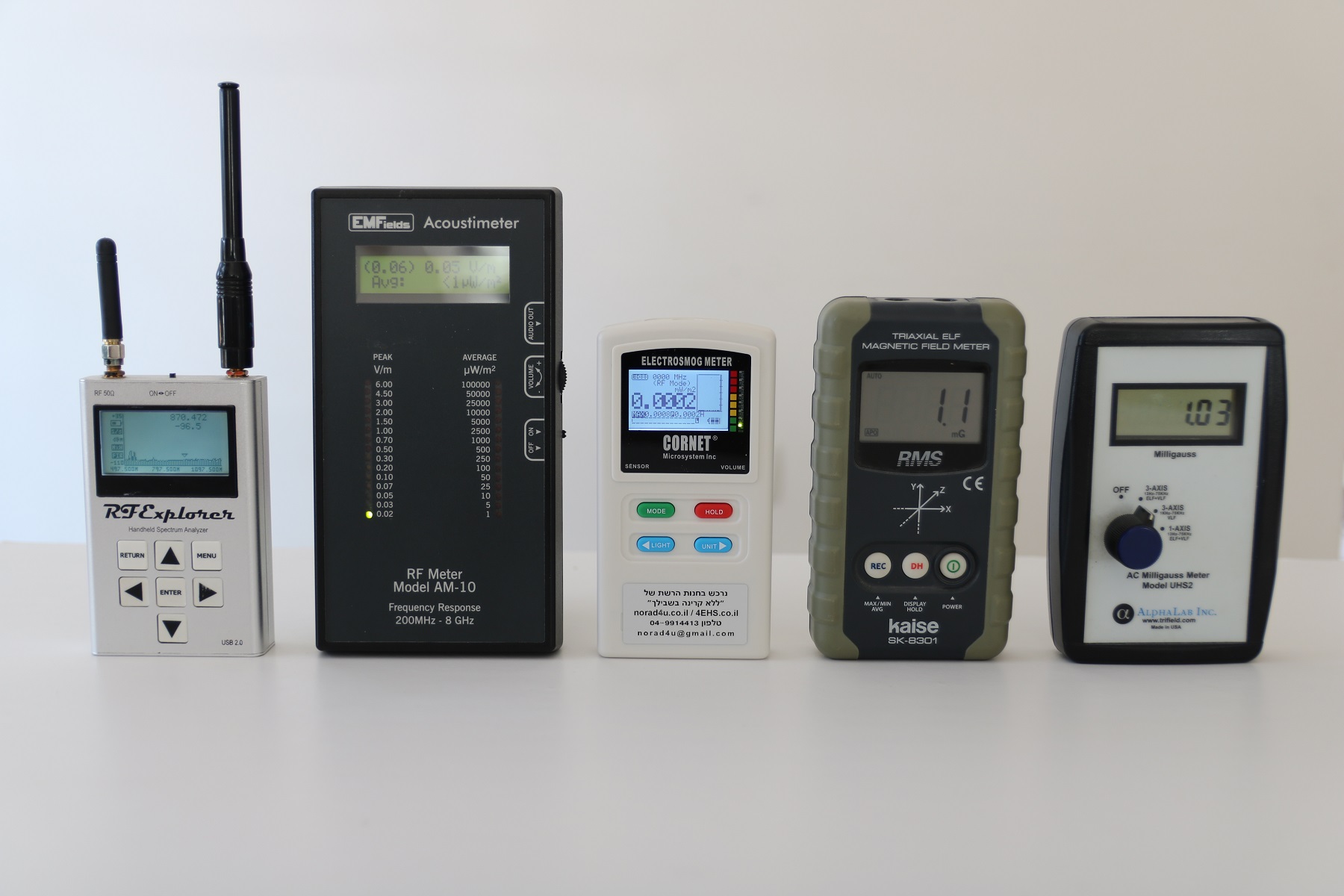
On this page, you can read reviews of home-use EMF meters, including leading models, specs, pictures, videos, explanations, and links from where you can order.
Using a home use, fast EMF meter
Measuring the EMF levels yourself using a fast EMF meter will be the best way to “see” the radiation, improve your knowledge, better understand EMF, find the source, keep safety distances, find penetration points, and see if your EMF protection really works. We believe that DIY EMF testing is the best way to test the EMF levels in the house and to handle EMF problems before any damage is done, or when you are already suffering from the possible health effects of EMF exposure.
We will emphasize again that the best way to measure RF radiation, the best way to find and identify RF sources (WIFI routers, smartphones, wireless laptops, and tablets) and penetration points, is to use a fast (high sampling rate) RF Meter that samples the RF levels thousands of times every second. a slow RF meter will not be able to “see” the low duty cycle home and personal RF sources such as smartphones, tablets, laptops, WIFI routers, BlueTooth devices, and other wireless devices.
A fast EMF meter is a basic “must-have” tool in the hands of every Electromagnetic Hyper-sensitive person. A fast EMF meter can serve you for several years on countless times and occasions, where and when there is a need to “see” the radiation around you.
We currently (03/2025) recommend the very simple to use ENV RD-100 or the very informative numeric EMF meter the CORNET ED98QPro5G.
VIdeo – The ENV RD-100 – https://youtu.be/42VlgcXOby4
Video – Recommended home use EMF meters for 2024 – https://youtu.be/GnwD7hTCN5w
Meters we will not recommend
On the market today you can find even cheaper meters, usually from China, but they will not be suitable for home use, mainly because of the low sampling rate of 2-10 times per second (same problem in some of the more professional meters that are built according to ICNIRP requirements). As I noted before, measuring a low-duty cycle signal from WIFI routers, smartphones, tablets, laptops, and other wireless devices, requires a very high sampling rate which this cheap china-made meter lacks.
Everyone can use an EMF meter
When ordering one of the meters we sell on our store site www.4EHSByEHS.com you will get video tutorials and links to information and step-by-step guides on this site. The videos and guides will allow you to shorten the learning curve and to understand what you are doing with the meter and what the results mean.
You should expect to put some time and effort into the process, but we will support you via email (send measurements pictures), and paid training via phone or zoom calls, is necessary.
My recommendation, plain and simple
For most people, I recommend the CORNET ED88TPLUS5G2 or the newer CORNET ED98QPro5G. It is fast, very informative, and has logging features for RF. For those of you who want a simple LED indition meter, the ENV RD10 is the best choice. In addition, you can get a few of the CelloEye detectors as your personal or home RF alarm system.
I recommend reading this page fully before buying an EMF/EMR meter. For those of you who want my recommendation, but don’t want to read the full explanation Please see the following table:
למזמינים לישראל, יש להזמין מהאתר הישראלי, לחצו כאן…
| Recommended for | Model | Frequency response | Picture and link | Buy now! |
| Most recommended (03/2025) Home use RF/ELF EMF meter with numeric info! Both LED light indication & numerical/graphic display. Great sampling rate(60000/Sec) for RF in Mudolation mode. Measure RF, ELF-Magnetic, and ELF-Electric fields. USB connection for recording and special future features. | ENV RD-100 | RF – 100MHz – 8GHz LFM – 30Hz – 25KHz LFE – 40Hz -10KHz | 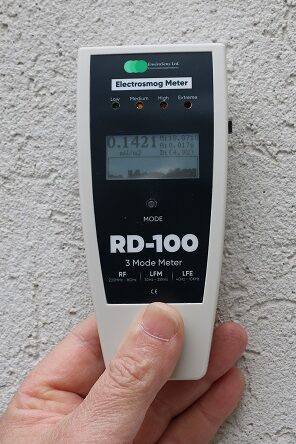 | Order from our store site www.4EHSByEHS.com |
| Recommended Home use RF/ELF EMF meter with numeric info! Great sampling rate(12500/halfSec). Measure RF, ELF-Magnetic, ELF-Electric fields. USB connection for future features. Earplug, many advanced features, and a detailed display | CORNET ED98QPro5G or CORNET ED88TPLUS5G2 | RF – 100MHz – 8GHz EL30 – 50Hz – 1KHz ELF600 – 50Hz -10KHz ELF Efield 50Hz-50KHz + Light/Flicker | 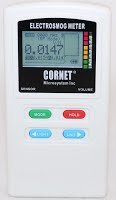 | Order from our store site www.4EHSByEHS.com |
| Tiny RF detector with a single led light indication for RF levels above 0.1mW/m2 | CelloEye 24G | 0.1-24GHz | Order from our store site www.4EHSByEHS.com | |
| Tiny RF detector with a single led light indication & buzzer for RF levels above 0.1mW/m2 | CelloEye 24Gs | 0.1-24GHz | Order from our store site www.4EHSByEHS.com | |
| Not available – Low price Home use RF/ELF EMF meter with Led Light and advanced features via USB connection. For those of you who need a fast & simple to operate EMF detector. For those who in a need to a pocket-size alarm detector. Measure RF, ELF-Magnetic, ELF-Electric fields. USB connection for future features. | ENV RF-10 | RF – 100MHz – 8GHz EL30 – 50Hz – 1KHz ELF600 – 50Hz -10KHz | 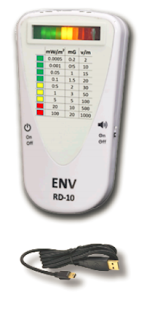 | Order from our store site www.4EHSByEHS.com or from Amazon.com |
| Simple RF Detector Very simple to operate Very simple to understand Led light indication Sound indication Single Button ON/OFF/Sound | Acosticom 2 | RF 200 – 8 000 MHz | 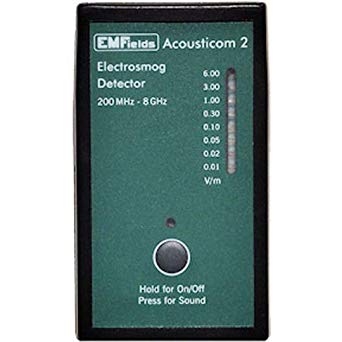 | This item is sold on Amazon.com at ~US$180, order at bellow links: https://amzn.to/2SKt67A https://amzn.to/32VL77C https://amzn.to/2MiDCSb http://amzn.to/2mTh4dK http://amzn.to/2myeO92 http://amzn.to/2uv5PtG |
| High-Quality RF Meter for the advanced user who wants an easy and clear reading, with audio feedback, an earpiece socket, Average and Peak values. Both LED bar and LCD display. Best measuring device for WIFI | Acoוstimeter AM-11 | RF – 200MHz – 8GHz | 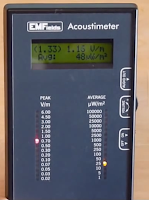 | This item is sold on Amazon.com at ~US$420 , order at bellow links: https://amzn.to/3AFZVXC |
| Home use ELF digital meter | UHS2 from Alpha Lab | 13Hz – 75KHz |  | Only $365.00UHS2 meter + Calibration test report + protective rubber (free Registered Air Mail delivery, will take 2-5 weeks) |
| Safe & sound Pro 2 Accurate and fast RF meter. Strong speaker. Show Max,Peak, Average levels. Does Not measure ELF magnetic or electric fields. | Safe & sound Pro 2 | RF – 200MHz – 8GHz |  | This item is sold on Amazon.com at ~US$435 , order at bellow links: https://amzn.to/3p675SQ |
| TRI FIELD 2 Nice meter for ELF electric and magnetic field. I don’t think it is a good choice for RF, since it measure also 20-100MHz signals including FM which can be in the way of identifying other RF sources. | TRI FIELD 2 | RF 20 MHz – 6 GHz Magnetic, 3 Axis – 40 Hz – 100 kHz Electric, 1 Axis – 40 Hz – 100 kHz |  | This item is sold on Amazon.com at ~US$435 , order at below links: https://amzn.to/3p4v05d |

Full meters review 12/2021
Video link – https://youtu.be/p-ELv0br7NM
How can a home-use EMF meter help you?
- Allows the identification of EMF sources inside your house/home
- Allows understanding what is the safety distance from ELF sources (in RF radiation, there is no real safety distance as even very low levels are not healthy).
- Allows the identification of RF penetration points via walls, windows, ceilings, and floors.
- Shoes which electric and electronic devices radiation, for how long and when.
- Allows you to see if, when, and how many steps that you take to reduce exposure are actually effective.
- Allows you to test, when and how much, EMF Protection steps are effective.
- You can give the meter to family and friends
- Allows you to measure the radiation in your home/office/car/workplace again and again.
EMF Measurement quick start guide with CORNET ED88TPLUS
Video – https://youtu.be/TtZkHmBGHRw
Video – https://youtu.be/TtZkHmBGHRw
What is important in a ‘home use EMF meter’?
- Sampling rate – the number of times the meter measures the radiation in a second and the way it calculates the level. This is critical for detecting RF radiation from cellphones, smartphones, WIFI routers, wireless laptops, tablets, smart home equipment, wireless earphones and earpieces, and other wireless devices and equipment.
- Easy of use and operation
- Clear and detailed display of data
- Low maintenance, should allow you to use it for years before breaking down
- Accuracy – For ELF meters accuracy is important, but not so much for RF. For RF meters is it more important that they will have as high as possible sampling rate so they will be able to pick up the fast-changing RF sources that exist in every house.
- Calibration – relevant only to professional meters that are used daily in hard conditions and exposure to high levels of radiation. In home-use meters, the calibration fees are usually higher than the cost of the meter itself.
Accuracy, is it critical?
Well, obviously accuracy is important but not critical. If the level of RF is 10mW/m2 and the meter show 1mW/m2 , there is a problem. But if it showed 9.5 and not 10, or even 7 and not 10 , I don’t think there is a problem there. As long as it shows the radiation (In RF meters, the ability to show the radiation is highly dependable on the speed the meter is able to measure it, the sampling rate. Which makes the sampling rate of the meter, to my opinion, the most important characteristic of a meter). and allows you to find the source or penetration point, the meter has done it’s job. Therefore I believe that finding the sources and penetration points of the radiation is more important in EMF measurement than the accuracy of the measurement.
Factors that influence the measurment other than the meter’s accurecy?
I know that to some of you this may sound strange, but I think that accuracy in a home-use EMF meter is not the main leading feature you should judge a meter by. In EMF measurement, especially in RF measurement lots of factors have an influence on the gap between the measurement you get from the meter to the real levels. Such factors are the type of signal you are measuring, the duty cycle of the signal, the frequency of the signal, the existence of other signals, the frequency span of the signal, the location you take the measurement, even the why you hold your meter can affect the outcome.
What is more important?
In most home use measurements, you usually need to know the levels only roughly. More often you would like to know where the radiation is coming from and you need the meter to show even the sorter-fastest signals. This means the meter has to have a high sampling rate.
Ease of use alongside an informative presentation of the outcomes is also a key factor in any meter and can shorter the learning curve while making the situation understood more quickly and easily (allowing the person who is doing the test to understand the exposure and the changing overtime of the radiation level. For example the display of Peak Value alongside with Max Value, Aהerage Value, Frequency & Histogram feature that shows the last 15 seconds of the measurement on a Level/time graf, all on the same screen of the CORNET ED88TPLUS – see picture below).
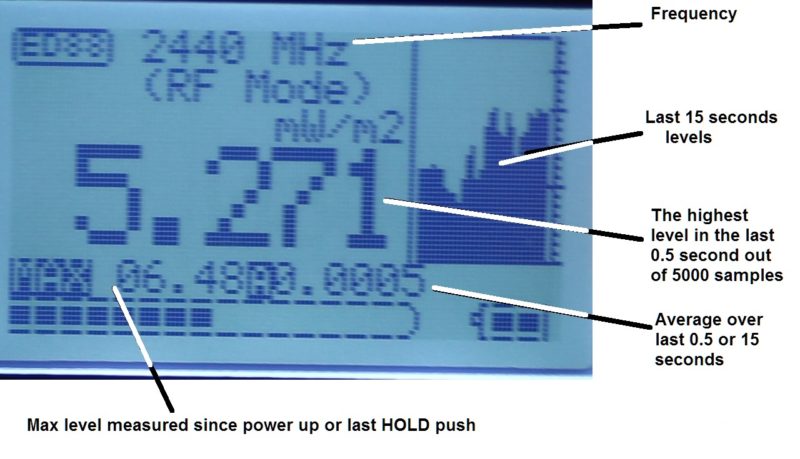
More info, explanations, guidance, and information
Before I will start explaining, reviewing, and telling you about different electromagnetic radiation (EMF/EMR) meters, I would like to point out that I am not trying to sell anything (I do sell meters, but not trying to “push” them). All the meters that I am going to review here were tested by myself, and I own most of them. I am writing here my reviews and comments about these meters, which I use daily. I hope that if you are looking into buying one you will be able to get some information from this page which will help you to understand the types of meters available in the market and to choose the one best for you.
Every house should have an EMF meter
I believe that every household should have EMF/EMR meters since in the home of today you can find many EMF/EMR sources. An EMF/EMR meter will help you expose most, if not all of them. after exposing the EMF/EMR sources you can start taking some actions to lower your exposure.
Buying EMF meters/EMR meters and detectors
EMR is Electromagnetic Radiation, and EMF is Electromagnetic frequency so as far as meters it is the same.
I believe that in most cases, buying your own meters is the right thing to do. Especially if you are electromagnetically hypersensitive (EHS). The best thing about having your meter is that it belongs to you and you can use it more than once whenever you need it. You can use it to find EMF/EMR sources in your house, workplace, or outside, just whenever you want or whenever you need it. You can use it to track and monitor the changing levels of EMF/EMR for a few days, months, or years, or even help your family and friends by measuring their houses.
A simple EMF / EMR meter can expose real EMF/EMR problems which can then be solved by you (moving or removing the sources or using EMF protection to block the EMF emitted from them). In addition, you can take the meter with you when you are out, buying new equipment for the house in order to make sure when and how much EMF/EMR the new equipment will emit (for example this is the best way to find out which cordless phones emit EMF/EMR all the time and which emit it only during conversation) or when searching for a new place to live in.
I believe that today every house should have at least one ELF+RF meter or two meters, one for extremely low frequencies (ELF) and one for radio frequencies (RF).
A ‘simple to operate’ ENV RD-100 or the CORNET ED98QPro5G RF+LFM+LFE+Light EMR meter should be enough to expose most EMF/EMR sources in your house or workplace and to give you a good picture of what is going on around you as far as EMF/EMR is concerned.
Advanced meters and spectrum analyzers can be right for you if you have some experience in the measuring of electronics, and after you gather some experience and knowledge about radiation. These meters are usually strongly built, have a Tri-axis sensor, are far more accurate but suffer from low sampling rate, and therefore will have problems detecting in-house RF sources and cell phones that emit low Duty cycle RF signals.
Where to buy
If you are looking to buy electromagnetic meters and searching for a place to buy, I can recommend our eStore web store (since 2012).
More details about all these products can be found on “For EHS by EHS” web site
www.4EHSByEHS.com site offers special products that were designed by EHS people in addition to EMF meters, EMF protection, RF blocking fabrics, RF Protection Clothes and RF Protection Hats.
Click here to read more…
In addition to that, you are welcome to use the links that I will give in the bottom of every review. Some of the meters can also be purchased on this site.
Different types and levels of EMF meters/EMR meters
Detectors
Very Simple EMF/EMR meters – Into this category fall all the detector/indicator type meters. These very simple meters can show you if there is or, there is not any radiation, a lot of EMF, or not so much, more or less but not an exact number. These meters have a very basic indication, usually a set of LEDs or a small gauge.
Home use Meter – Basic and Advanced
Simple home use EMF/EMR meters – simple EMR meters that in addition to a basic indication gives also a numeric measurement value.
Usually, it cost from 50$-200$ (or more).
Advanced home use EMF/EMR meters – EMF/EMR meters that display different types of information on a specially designed LCD. These meters can usually measure EMF/EMR in 3 axes and have advanced features like HOLD, MAX, AVERAGE. Some of them even have an internal logger (able to track EMF/EMR levels over time) option and can be connected to a computer for data analysis.
Usually cost from 150$-500$ (or more).
Professional safety survey meters
High quality, strongly built, advanced meters with high precision and accuracy that address the professional safety survey market needs. These meters will usually have many advanced features some programmable options. These meters will usually build according to ICNIRP or IEEE specifications. Most of the meters from this type that is currently (2019) on the market have a slow sampling rate.
Usually, it cost from 200$-50000$ (or more).
Professional Development meters and Spectrum analyzers
Usually for lab use, High quality and very high sampling rate (few Giga sampling rate per second, up to hundreds of Giga). used for the development and debugging of equipment during the development phase.
Usually cost from 50000$-and more.
Measurements of Multi-frequency signals and multiple sources
Please note that most of the High-frequency electromagnetic radiation meters that I encountered to date (both professional and simple) are not able to measure multiple frequencies and multiple radiation sources correctly (mobile, WIFI, cellular antennas, cordless phones, etc.). This limitation is due to the difficulty of measuring and summing up all the radiation levels in all the frequencies. Therefore the measurement of radiation sources that emit RF radiation in several frequencies (eg: WIFI, mobile phone antennas mailman third, or cellular) or measuring several radiation sources at once may not be accurate and generally results in low measurements. It is still possible to use these meters to expose radiation sources and to understand how to shield and how reduce your exposure to them.
For example, a slow sampling rate will “see” the RF from a WIFI router only at a distance smaller than 0.5 to 1 meter away from the router. A fast RF meter (such as the CORNET ED88TPLUS) will “see” the RF from the WIFI router at about 5-10 meters from the router, but still, this measurement will be partial.
Comparison between different EMF meters on the market
The following table will try to make it easier for us to explain why we recommend the ENV RD10 and the CORNET ED98QPro5G meters. The table summarizes my views on the following meters. The recommendations are according to our experience in using, selling and training people to use EMF meters.
| Meter/Ability | ENV RD10 | CORNET ED88T PLUS 5G2 or newer CORNET ED98QPro5G | TRI FIELD 2 | UHS2 | Acoustimeter AM11 | Safe & sound Pro 2 | TENMARS TM196 |
| Simple and easy operation | Yes | Yes | Yes | Yes | Yes | Yes | No |
| Easy to read | Yes | Yes, with detailed display | Yes | Yes | Yes | Yes | No |
| Measure/detect pulsed RF radiation from personal wireless devices (smartphones, smartwatches, wireless earpieces…) | Yes | Yes | Yes | No | Yes | Yes | No |
| Measure/detect pulsed RF radiation from home/office wireless devices ( smart meters, wireless laptops, wifi routers & access points, cordless phones…) | Yes | Yes | Yes | No | Yes | Yes | Partially |
Measure cell towers 2G/3G/4G/5G | Yes | Yes | Yes (picks up also FM which gets in the way) | No | Yes | Yes | Partial |
| Measure/detect ELF magnetic & electric fields | Yes | Yes | Yes | Magnetic | No | No | No |
| Can be used during the exposure reduction and protection process | Yes | Yes | Yes | For magnetic field | For RF | for RF | No |
| Accurate measuring RF (including pulses) | No | No | No | No | Considered more accurate than the CORNET | Considered more accurate than the CORNET | On paper Yes, in reality No |
| 3 Axis RF measurement | No | No | No | No | No | No | Yes |
| Accurate measuring ELF | No | No | Yes | Yes | No | No | No |
| Calibration certificate | No | No | No | Yes | No | Yes | Yes, from China |
| Recommended by us for home use, for RF and ELF source detection, exposure reduction and protection | Yes, a specially for people who prefer light bar over numeric measurement, for training and as a pocket meter for EHS people. | Yes! a great ‘all-in-one’ EMF meter for home use. | No | Yes, For advanced users | Yes, For advanced users | Yes, For advanced users | No |
| Price range | starting at US$139 Not available anymore | US$310 | Starting at US$168 | starting at US$365 | starting at US$420 | starting at US$435 | starting at US$330 |
ENV RD-10
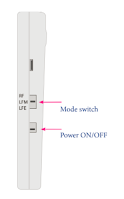
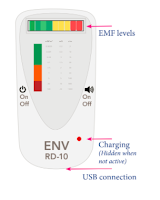
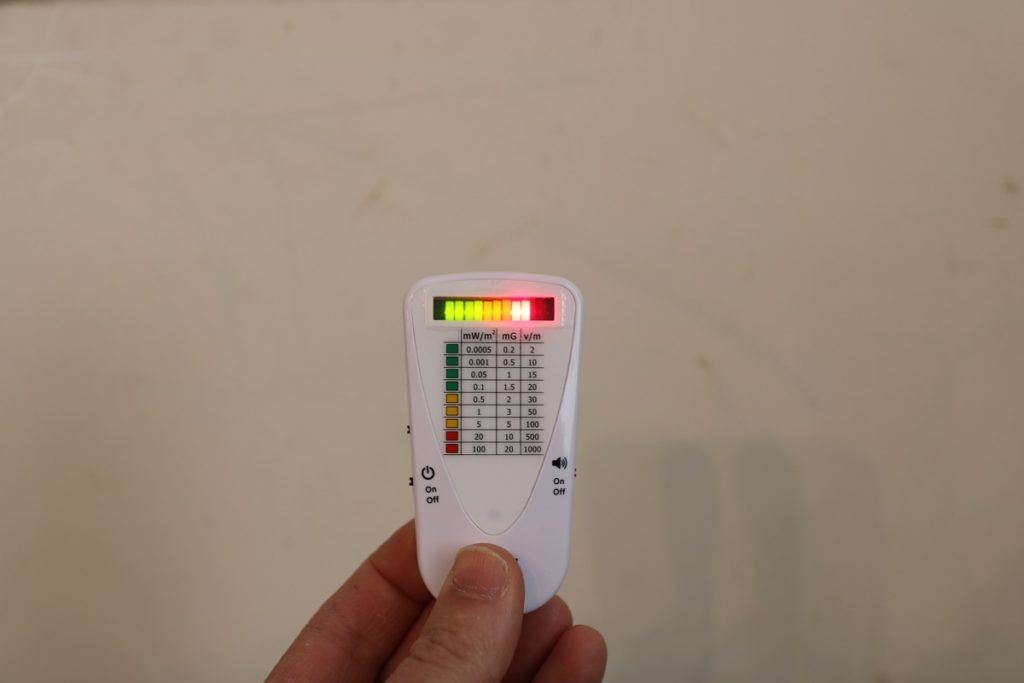
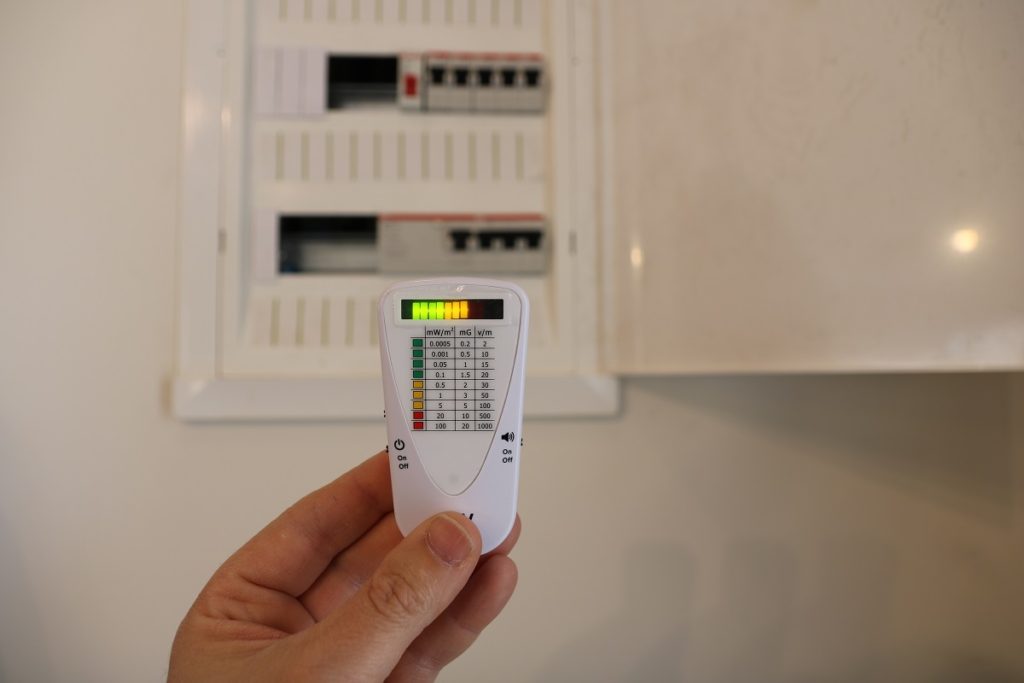
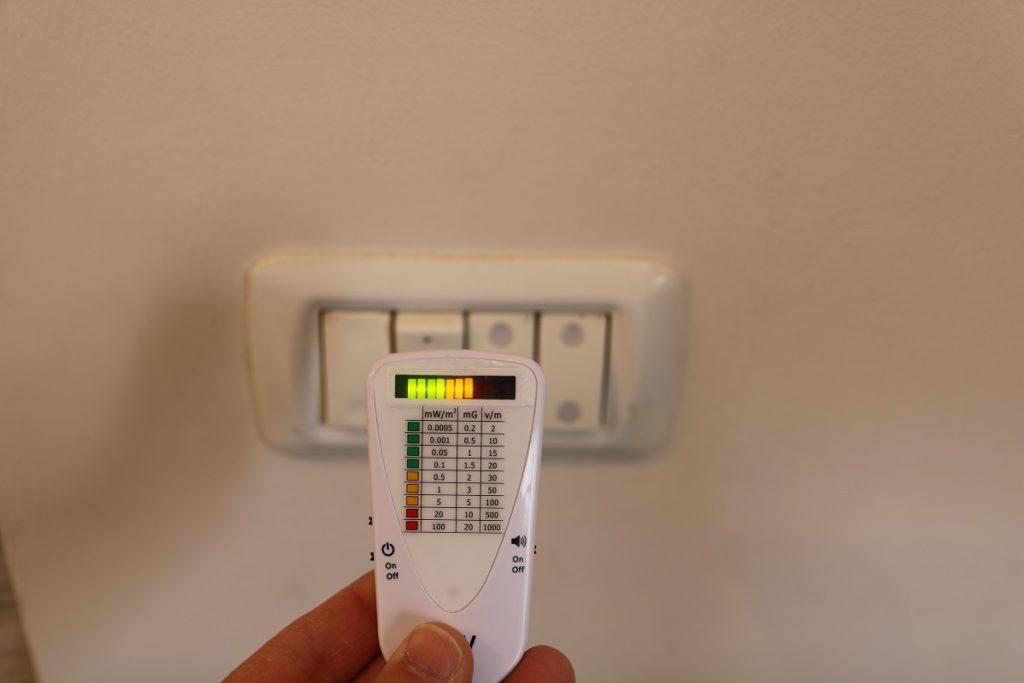
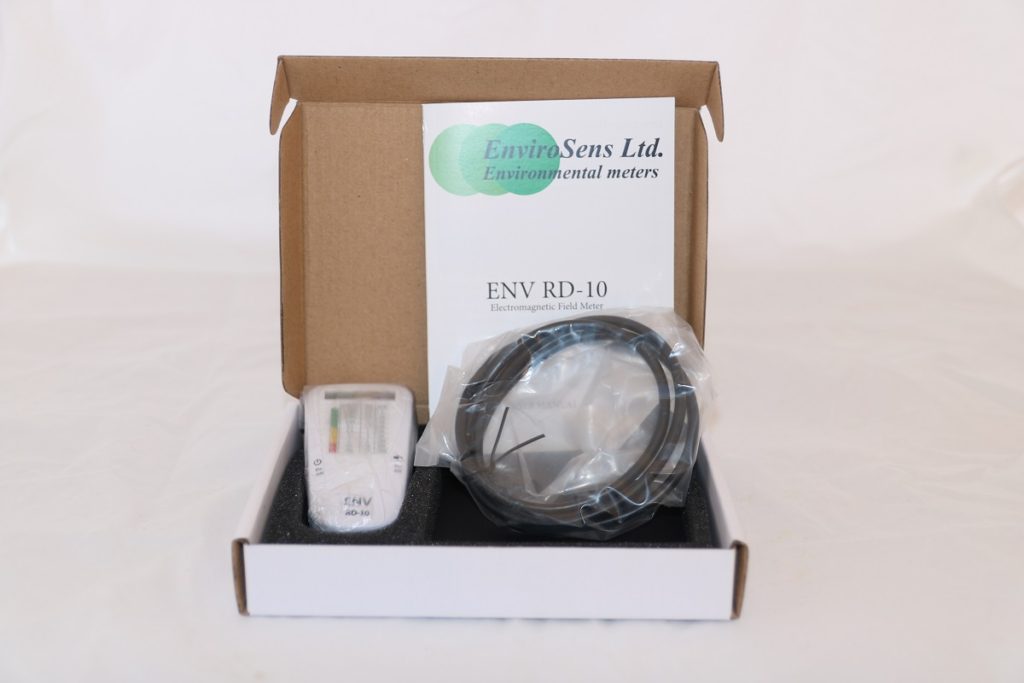
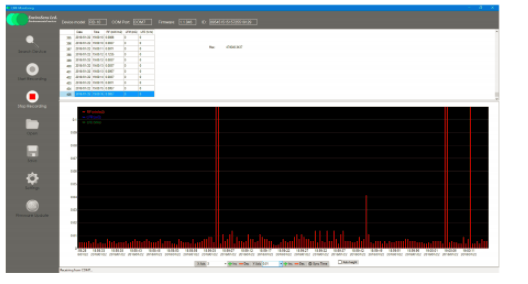
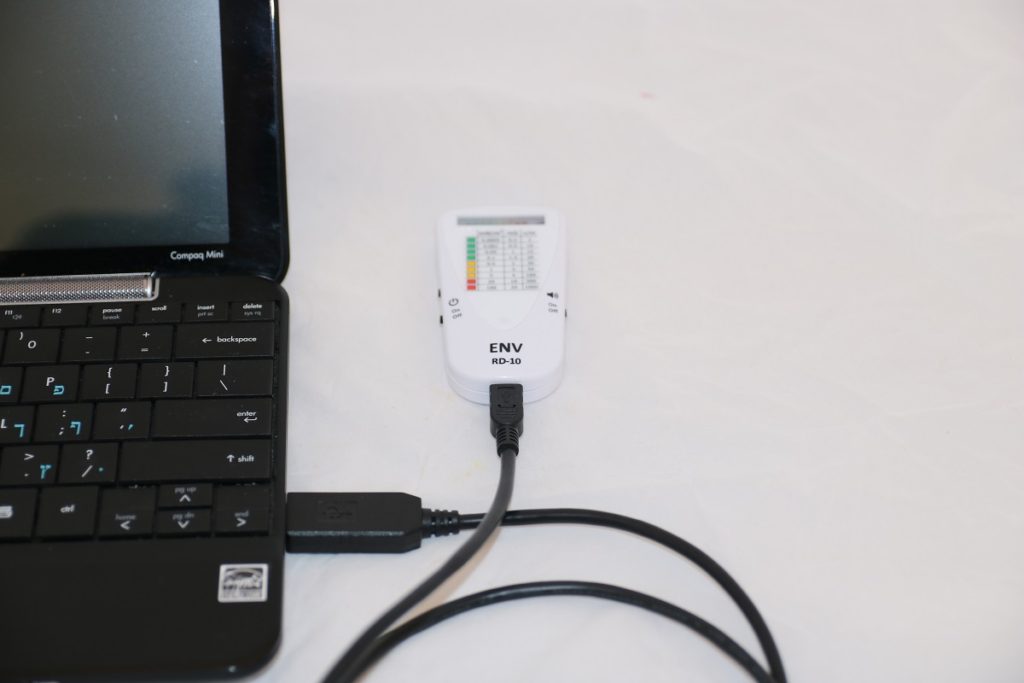

Order from our store site www.4EHSByEHS.com
Low price Home use RF/ELF EMF meter with Led Light and advanced features via USB connection.
For those of you who need a fast & simple to operate EMF detector. For those who in a need to a pocket-size alarm detector. Measure RF, ELF-Magnetic, ELF-Electric fields. The USB connection for recording measurements, software upgrade and more.
Description
A very small, fit into your pocket, very fast and sensitive EMF (both RF/ELF-M/ELF-E) Radiation detector. It can be used as a simple EMF Smog meter, showing the levels via the color led bar. It can be used as an Alarm RF/ELF detector for EHS (Electromagnetic Hypersensitivity) people. It can be used as a monitor while connected to a PC via the mini USB cable. Has an Internal rechargeable (via USB) battery that can last for hours.
The fast sampling rate will allow the meter to pick up even the fastest RF signals. The meter displays the levels of EMF over a Green-Yellow-Red Led lights, making it easier to read even if you are not an expert. If you are an advanced user, you can connect the meter to a PC and get the exact readings.
Advantages and features
- Very fast sampling rate- Most important (20000 samplings every second).!
- Very easy to operate and read
- Both RF and ELF (magnetic & Electric fields) in one very cheap meter.
- Rechargeable batteries (via Mini USB)
- Small case – Fits into every pocket
- Advanced features for advanced users via Mini USB connection to a PC
- Future software update via Mini USB
- Super sensitive RF alarm mode will allow you to walk around with the meter for hours. The meter will alert you when being in a high RF environment or close to a source or a cell phone user.
- Audio Feedback – beeps
- USB connection
- Color Led Light Bar
- Single Axis RF meter, mW/m2, dBm, bandwidth of 100MHz-8GHz
- Single Axis LFE magnetic meter, mGauss, uT, bandwidth of 50-10KHz
- Single Axis LFE Electric field meter, V/m, bandwidth of 50Hz-50KHz
- Sampling rate: 20,000/sec, display rate 5/sec.
- Internal antenna and sensors.
- 90 days money-back guarantee
- 1 year warranty
- Made in ISRAEL
- Software and future updates can be download from http://www.envirosens.com/
Disadvantages
- Single axis
- No numeric display
Bottom line
Great & cheap EMF detector for those who need a Red-Yellow-Green indication, for those of you who need the alarm, or for those who what to do some monitoring (with a PC).
Video:
Operating the ENV RD-10 – https://youtu.be/ksYC5_HNuCsUnboxing and Presentation – https://youtu.be/T_f3xQPINOw
Manufacture’s datasheet:
- RF Frequency range: 100MHz to 8GHz
- RF measuring range: -60dBm to +5dBm
- RF Typical accuracy: ±6 dB
- LFM (magnetic field) Frequency range: 50Hz to 10KHz
- LFM measuring range: 0mG to 50mG with 0.1mG resolution
- LFM accuracy: 20%
- LFE (electric field) Frequency range: 50Hz-50KHz
- LFE measuring range: 2v/m to 1000v/m
- LFE accuracy: 25%
- Display: Sampling rate:
- Sampling rate: 20,000/sec (updates 5 times a second on the LEDs / 2 times a second for USB data)
- RF technologies: Analog RF and Digital burst RF (GSM, TDMA, CDMA, LTE, DECT, ZigBee, Bluetooth, UWB, Wi-Fi, WiMAX 2.4GHz, 3.6GHz, 5.8GHz, 2,3,4 generations).
CORNET ED88TPLUS5G2/ ED98QPro5G
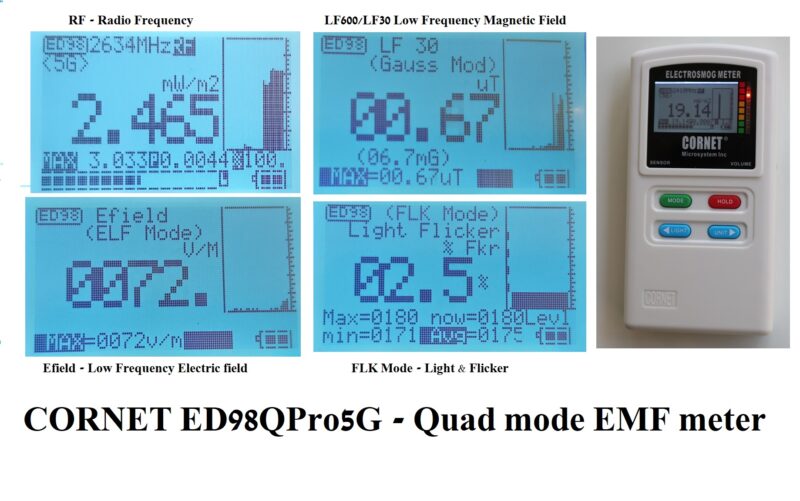
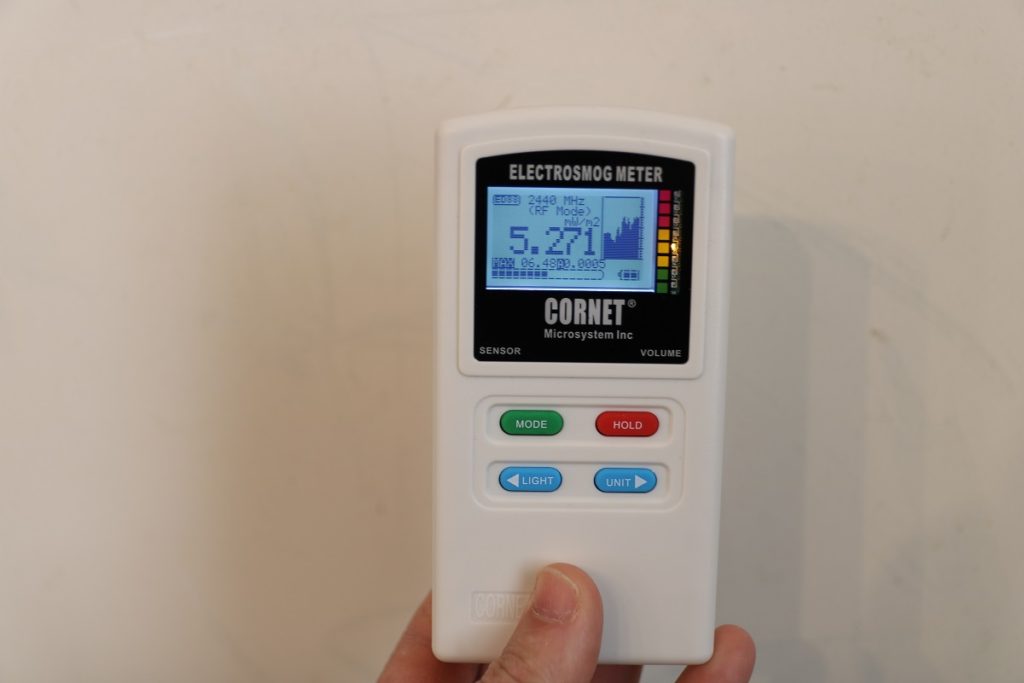
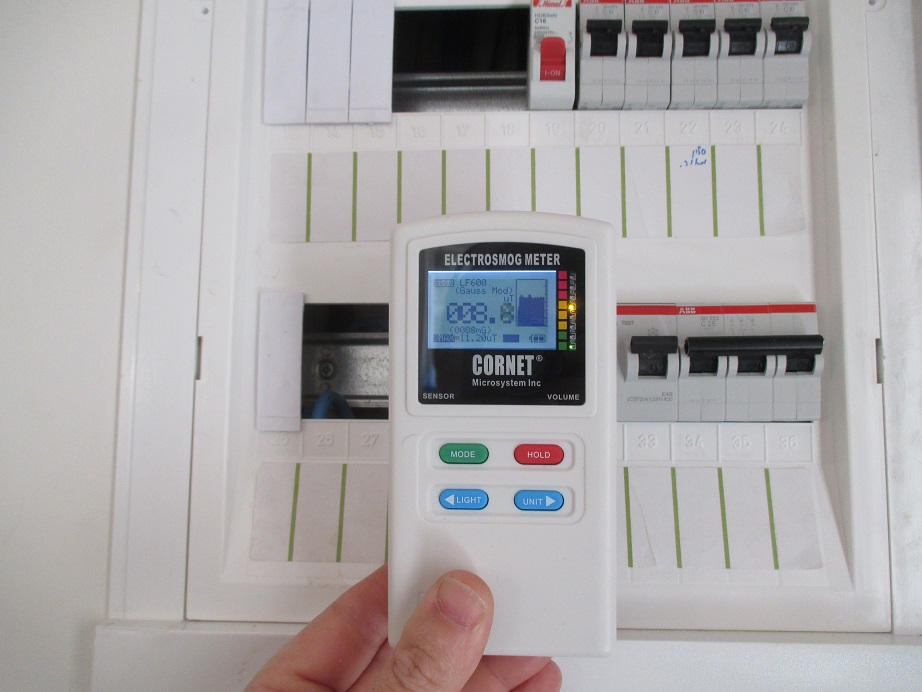
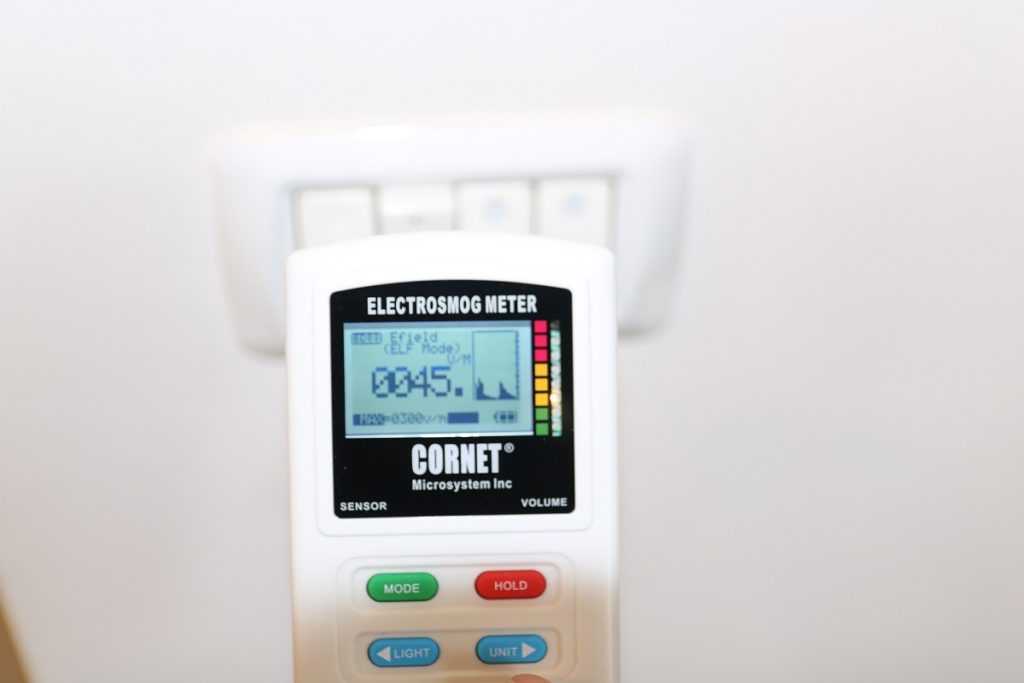
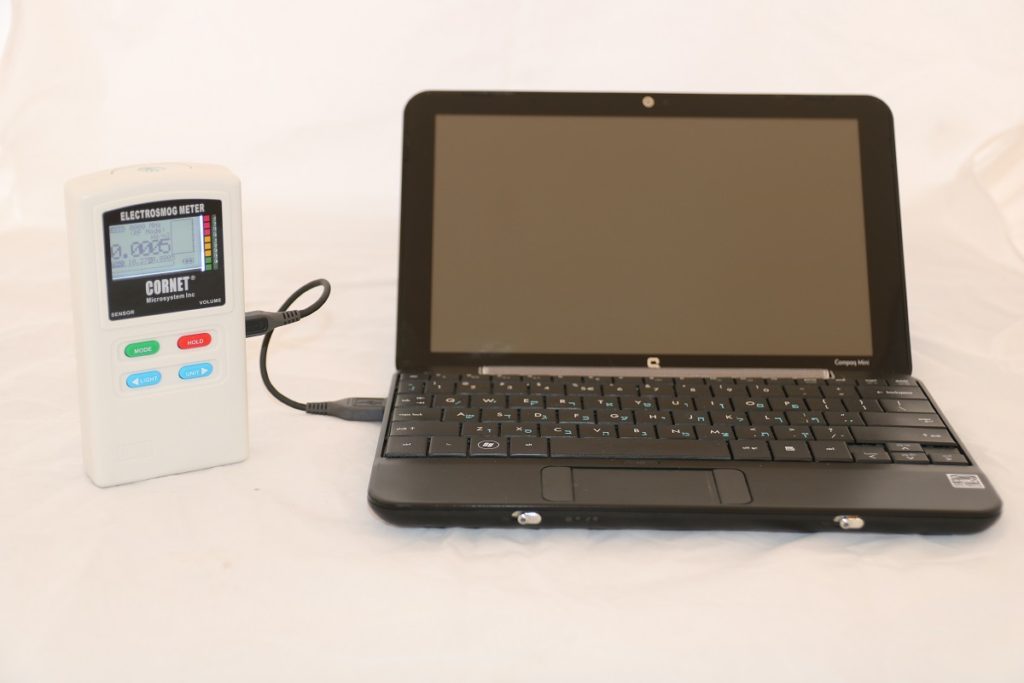
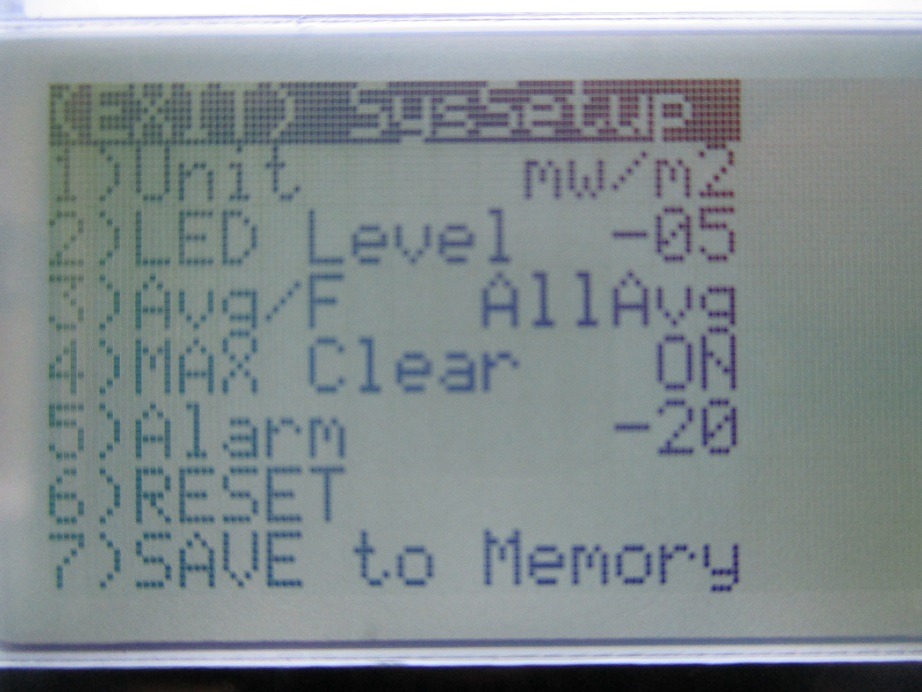
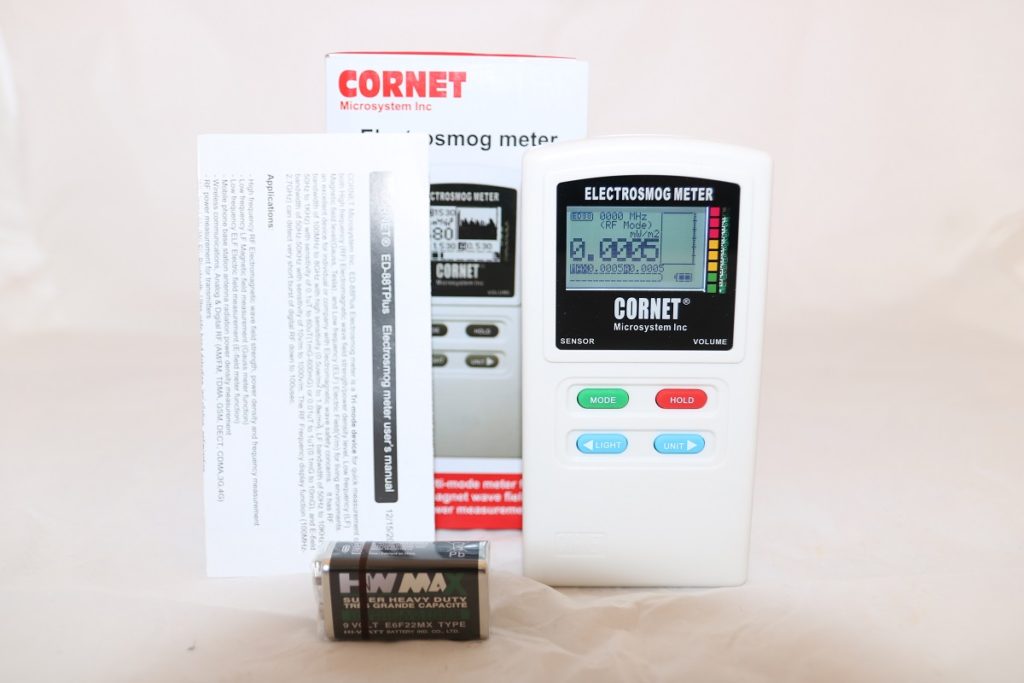
Order from our store site www.4EHSByEHS.com
CORNET ED98QPro5G is an improvement of the CORNET ED88TPLUS5G2. In addition to all the great features in the 88, the 98 has also a light sensor and it can measure both light strength and light flicker levels.
Video presentation of the CORNET ED98QPro5G
Link – https://youtu.be/UKFBZLq7bR8
Link – https://youtu.be/UKFBZLq7bR8
Key features:
- New in ED98QPro5G – Light strength in Lux units.
- New in ED98QPro5G – light flicker in %
- New in ED88TPLUS5G2 – Logger view can show RF waveform if time interval is set to 1mSec.
- New in ED88TPLUS5G2- Statistical view can now partially show the RF waveform
- New in ED88TPLUS5G- Duty cycle display in RF mode.
- New in ED88TPLUS5G- Logger view and Statistical view.
- New in ED88TPLUS2 – History Log in RF mode of up to 512 seconds.
- New in ED88TPLUS2 – Sampling rate up to 25000/sec (used to be 10000/sec)
- New In ED88TPLUS2 – Duty Cycle calculation
- Single Axis RF and ELF meter (most RF sources are in Y axis. ELF sources usually radiate in 2 axis).
- Both for RF and ELF measurement and source detection
- Very sensitive RF(down to 0.0005mW/m2) and ELF(0.005uT/0.05mG) modes
- Very Fast RF meter (most important for an RF meter, 12500 measurements for every half a second and displaying the max level measured in the last half second).
- RF mode from 100MHz up to 8GHz (from 0.0005mW/m2)
- ELF Magnetic mode LF600 – from 40 to 10KHz and up to 600mG
- ELF Magnetic mode LF30 – from 40 to 1000Kz and up to 10mG (very sensitive ELF mode).
- ELF Electric field mode Efield – from 50Hz to 50000Hz and 2V/m up to 1000V/m
- RF mode – Audio-sound feedback
- RF mode – Adjustable audio alarm to levels of 0, -5, -10 ,-15, -20, -25, -30, -35 dBm.
- RF Led bat – Adjustable sensitivity
- RF+ELF M + ELF E modes – Display Max measured value since power up
- In RF mode, display Average level over last half a second.or over last 15 seconds.
- RF measurement in dBm, V/m, mW/m2
- Improved sensitivity in ELF, shows levels from 0.1 mG and up (0.5 in the ED75)
- LF600 mode for low frequency from 0.05uT (0.5mG)
- LF30 mode for low frequency from 0.01uT (0.1mG)
- ELF measurement in uT, mG.
- The histogram graph (level/time graph) shows the values measured in the last 15 seconds. Helps you see fast signals and how the radiation levels change over time. Great for RF/ELF source hunting.
- Improved LCD display
- Back Led light feature.
- Led Lightbar that marks the radiation level if you are having a hard time with the numbers).
- 9V battery
- Battery strength indication
- Earphone socket
Order from our store site www.4EHSByEHS.com
The Acousticom 2 RF Detector

The Acousticom 2 is very simple to operate and very nicely built, very light and very small, RF detector, manufactured and sold by EMFields.com. This very basic RF detector is idle for people who don’t want to mess with reading fast-changing numbers or for presentations and videos, as the reading is very clear. It is also equipped with a built-in speaker which sounds the RF signal modulation, allowing you to identify the type of the RF radiation being measured. It comes with a carry pouch, a short user manual, and a 9V battery.
Advantages:
- Very light
- Very simple to operate
- Audio feedback
- Very sensitive (as low as 0.01V/m, up to 6V/m).
- Measure peak levels
Disadvantages:
- No numeric display.
Bottom line:
Very nice, small, light RF detector for the novice user.
Where to buy:
Use the links in the below table. Sold be a web store in England. Prices are in British Pounds, not including VAT. You may need to pay taxes on supply.
Buy on amazon.com
https://amzn.to/2SKt67A
https://amzn.to/32VL77C
https://amzn.to/2MiDCSb
http://amzn.to/2mTh4dK
http://amzn.to/2myeO92
http://amzn.to/2uv5PtG
PF5 Pocket Power Frequency Meter (ELF & VLF)

An ELF magnetic & electric field detector for home use.
Detect both ELF Magnetic (in mG) and Electric (in V/m) fields from 20H-50000Hz.
Advantages:
- Very light
- Very simple to operate
- Detect both electric and magnetic fields
- Very sensitive (as law as 0.2mG and 5V/m).
Disadvantages:
- No numeric display.
- Single Axis.
Bottom line:
Very nice, small, light ELF detector for both Electric and magnetic fields for the novice user.
Buy from:
Starting from US$178 at Amazon.com – http://amzn.to/2my7rid, http://amzn.to/2m5Cdm2Combo 1: Acousticom 2 RF Detector + PF5 EMF Detector: http://amzn.to/2my7xGmCombo 2: Acousticom 2 RF Detector + PF5 EMF Detector + Dirty Electricity GS meter :http://amzn.to/2n3kkUr
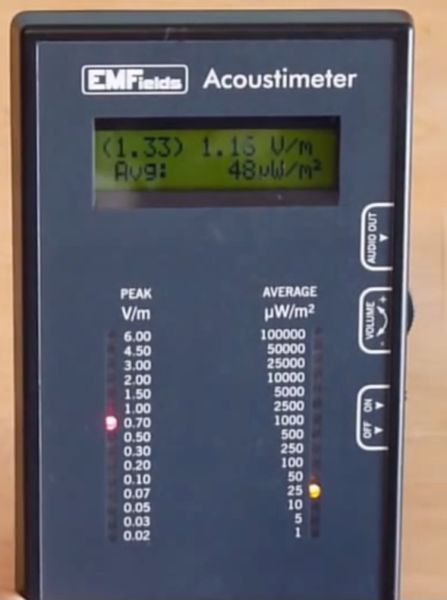
Acoustimeter AM-10 RF meter
The Acoustimeter AM-10 RF meter is a digital RF meter that can measure between 200MHz up to 8GHz.The meter comes in a hard plastic hand carry case in which it is covered with an RF blocking cloth that can be used also for demonstration. The Acousticmeter has both a 2 line LCD and 2 sets of color led strength bars and a LCD display in which you can see the Max RF electric field measured (since power-up) , the Current electric field strength (both in V/M) and the Average electromagnetic power density flux in uW/m2 units. The left LEDs raw display the peak RF electric field in V/m units and the right led raw display the average RF power flux in uW/m2 units. On the left side of the meter, you will find the on/off switch, a volume dial and a headphone jack (for audio feedback).On the back of the meter, you will find the audio speaker and the battery compartment (2 AA batteries).
Advantages:
- Up to 8GHz
- Both peak and average (average is done over 1024 samples which are taken over 0.35 seconds).
- Nice handy, protective case
- Fast (for fast-changing sources).
- Very sensitive
- Audio feedback
Disadvantages:
- Some of the measurements are in V/m and some in uW/m2
- Big
- Expensive
Bottom line:
Very good, easy to use RF Meter, very good for demos and videos.
Where to buy:
Use the links in the below table. Sold be a web store in England. Prices are in British Pound, not including VAT. You may need to pay taxes on supply.
Buy on Amazon.com:
https://amzn.to/2YuhMBU
https://amzn.to/3109sre
https://amzn.to/2Yqzcz5
http://amzn.to/2mya1Ve
http://amzn.to/2mNhOiW
http://amzn.to/2n3oHyS
RF EXPLORER 6G Combo
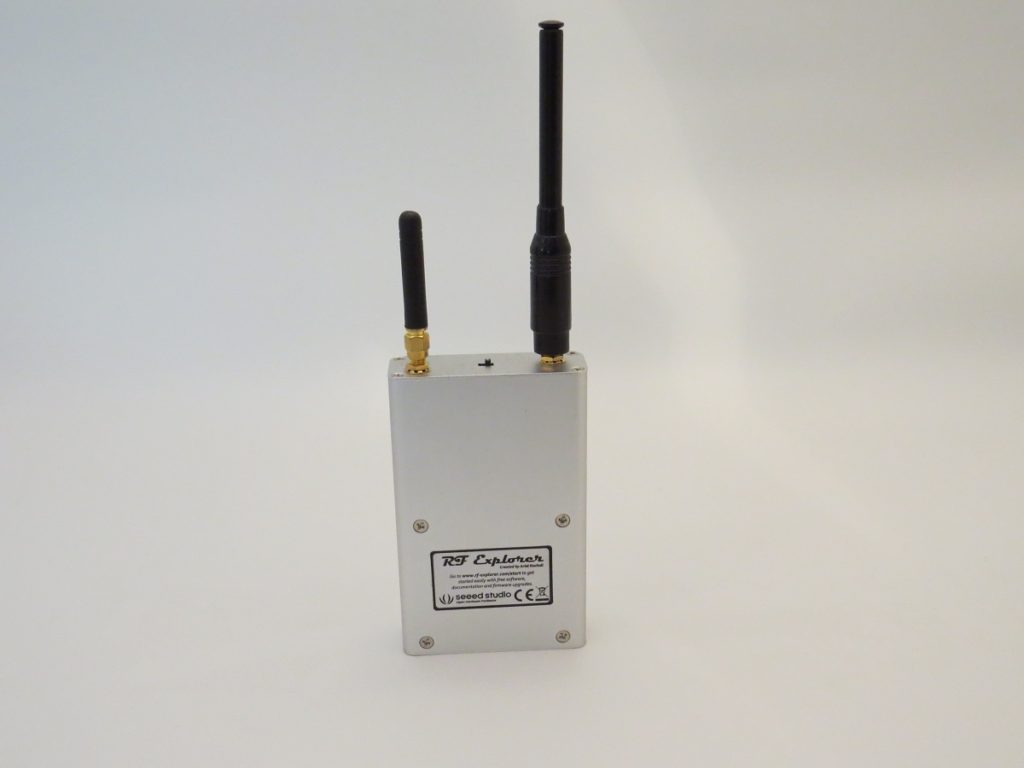
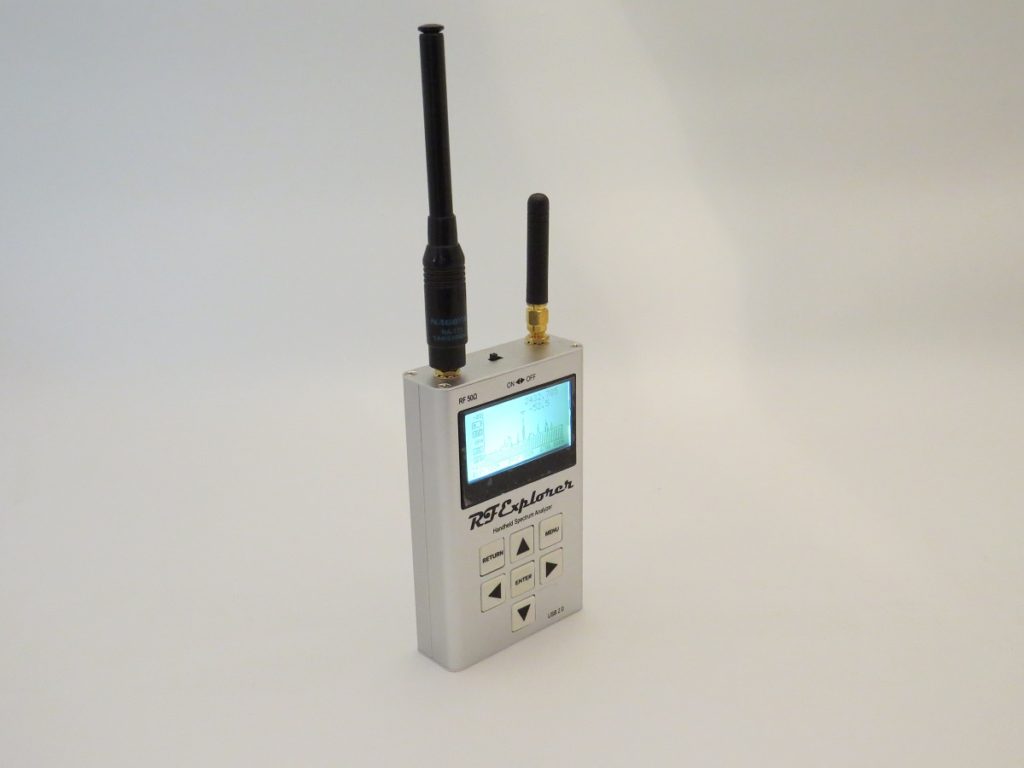
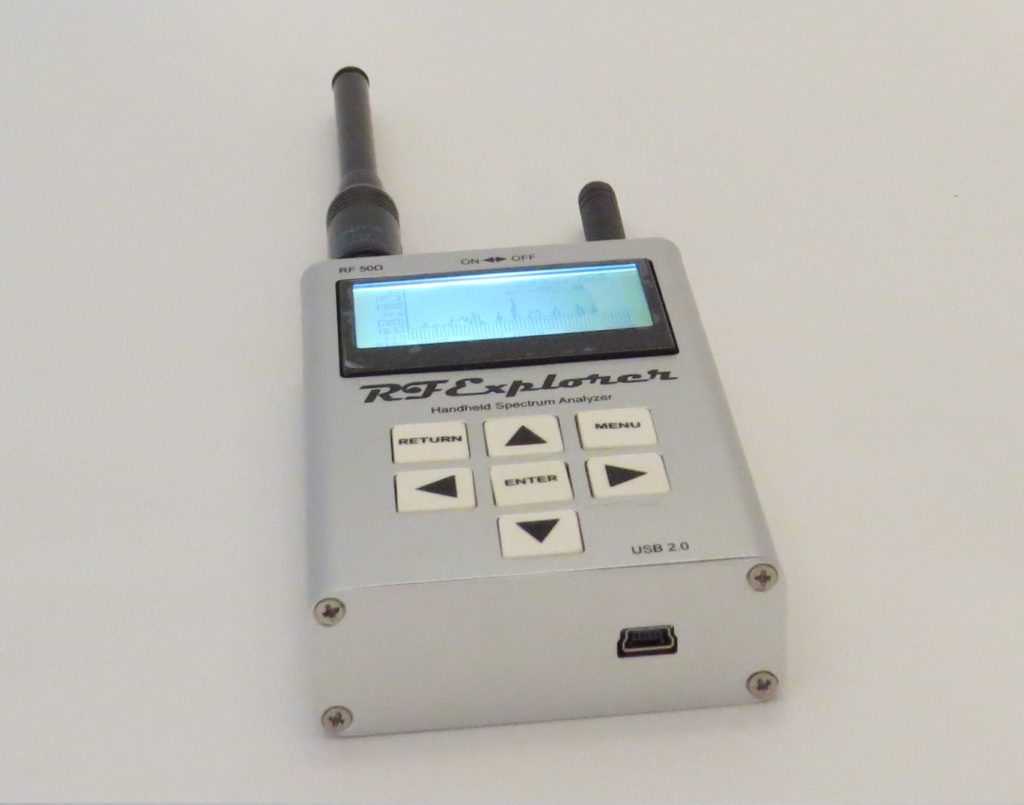
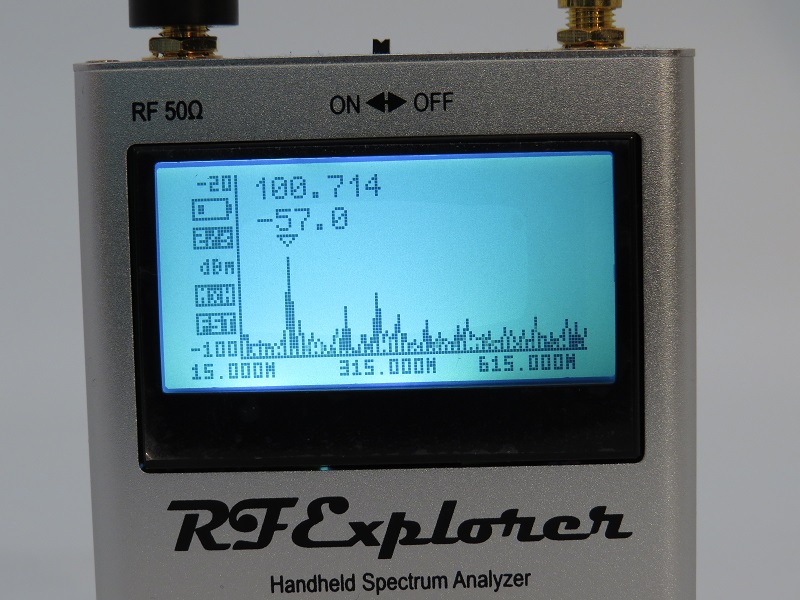
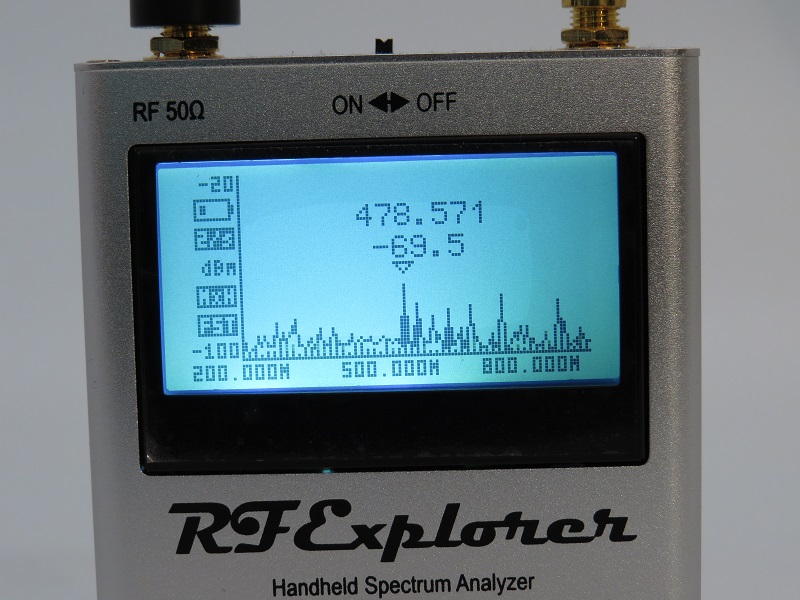
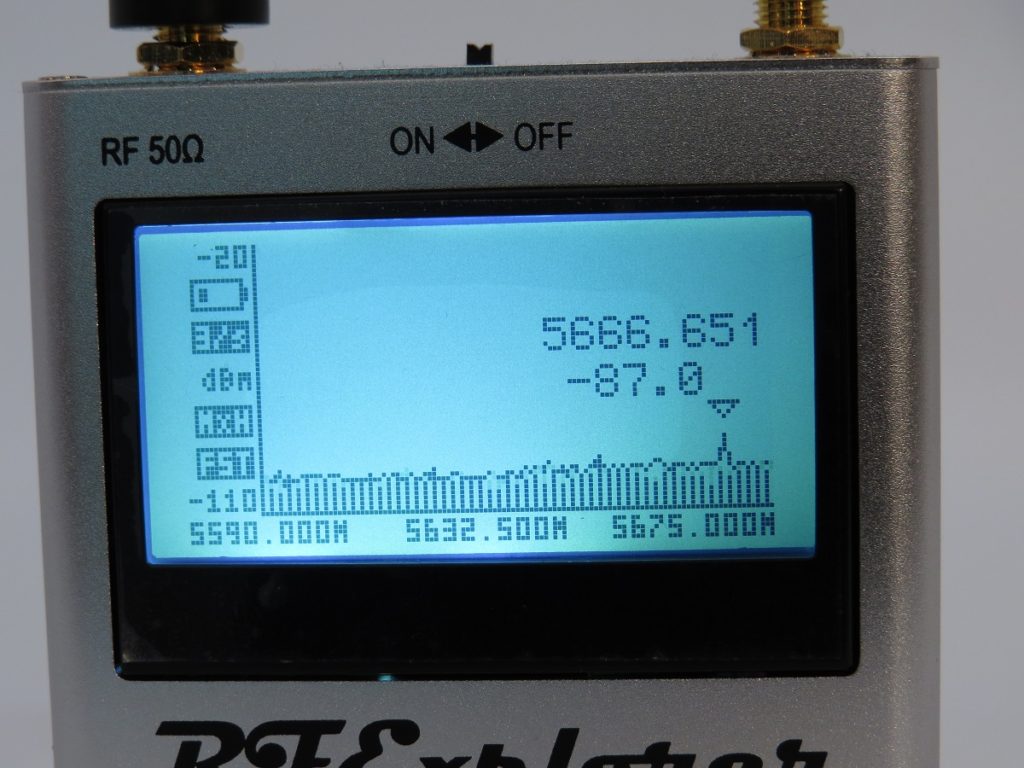
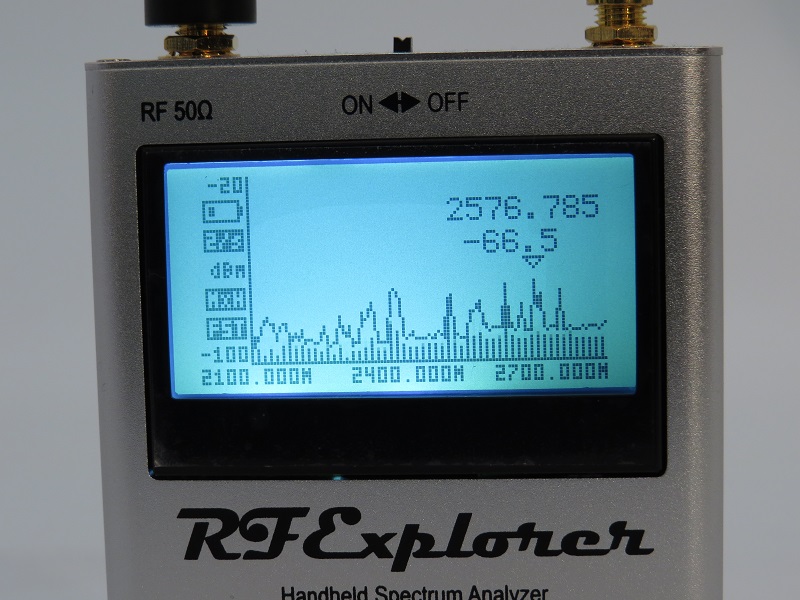
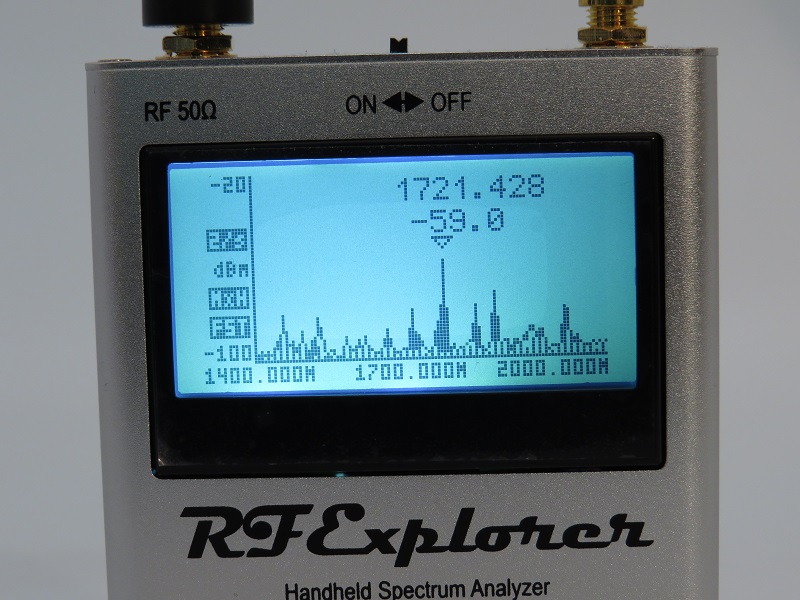
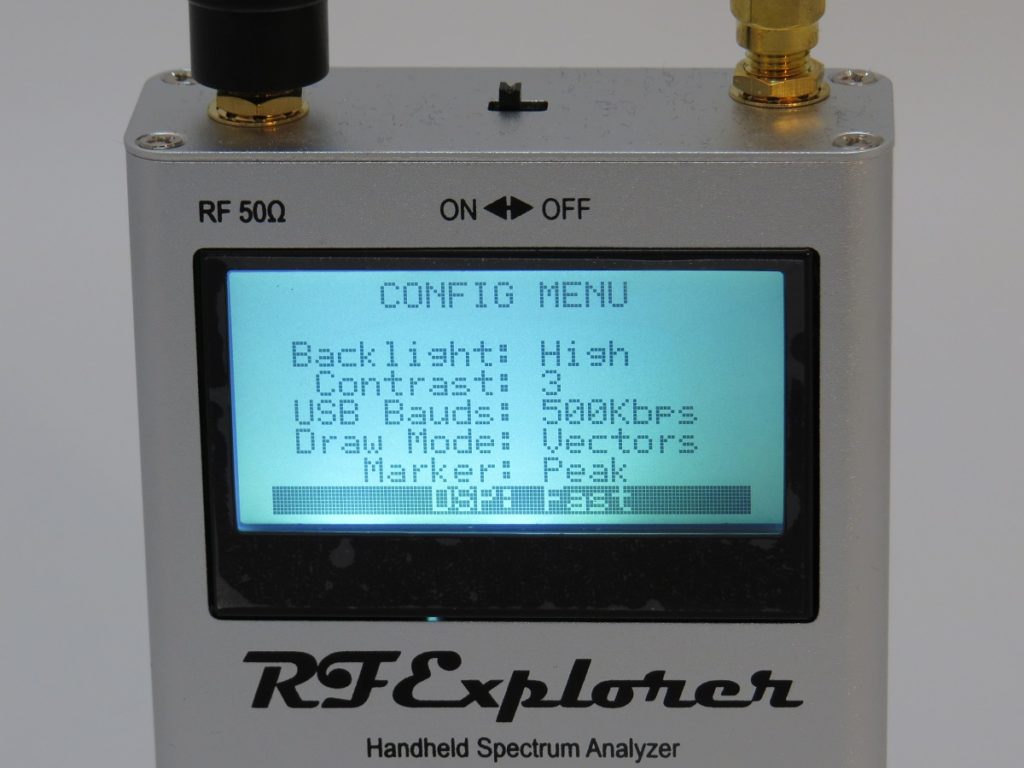
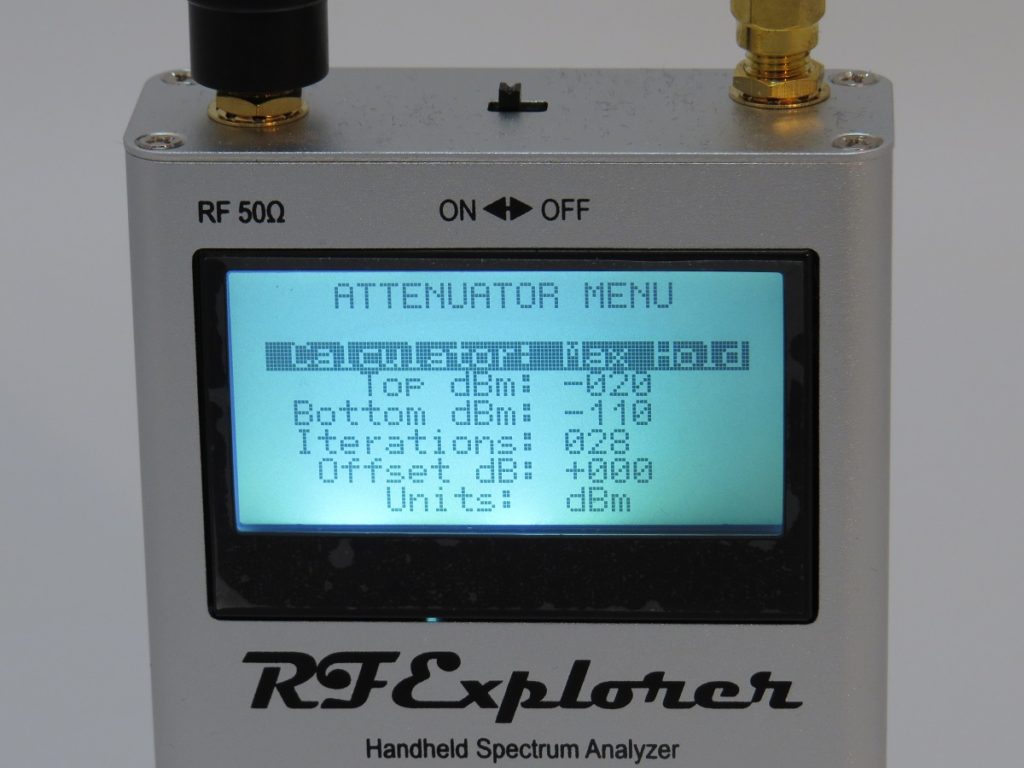
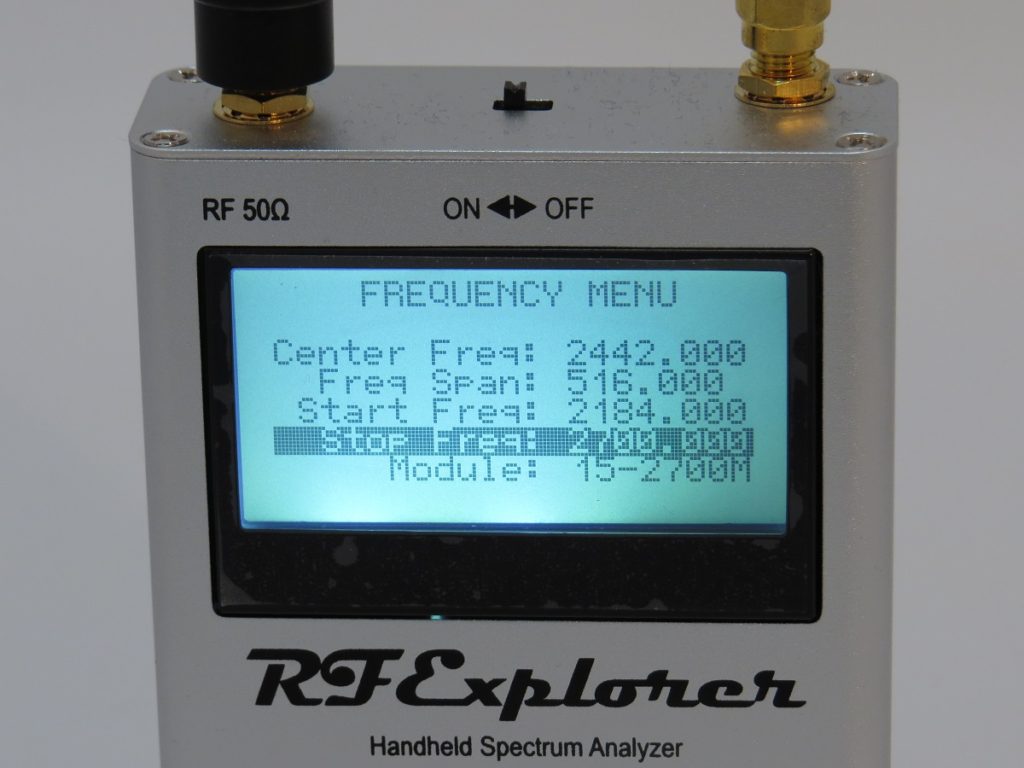
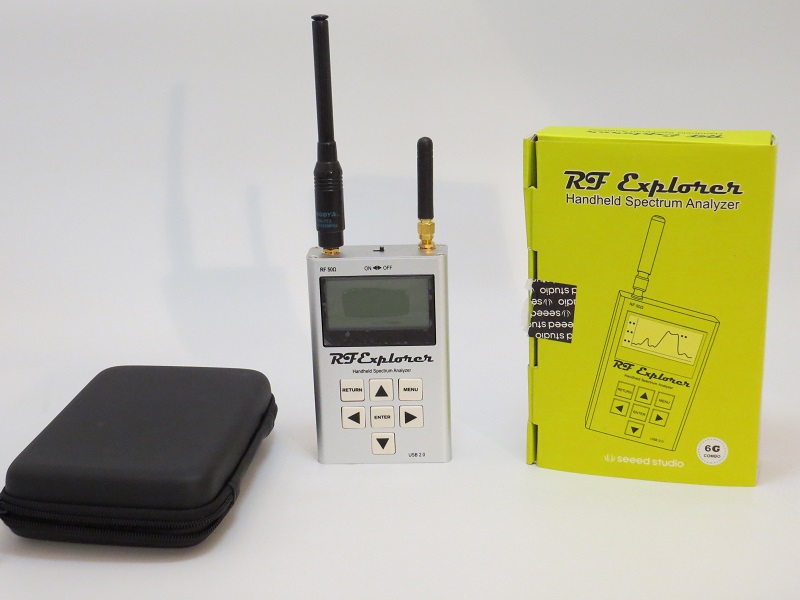
order from Amazon.com
6G Combo + Signal Generator – https://amzn.to/310HGea
6G Combo – https://amzn.to/2LJduAz
3G Combo – https://amzn.to/2LIB8gH
Signal Generator – https://amzn.to/2yfxa6j
The RF EXPLORER is a very cheap, low cost, very nice RF Spectrum analyzer. The key feature of this device is to show you the signals over the frequency span (RF meters show signal over time). Perfect for the semi-professional user and for activists and EHS people that know their way around RF signal analysis. It is not for every user as the operation and understanding of the display require some knowledge in electronics and RF signal formation.
Specifications:
- Frequency Range by sub models :
3G Combo 15-2700MHz
6G Combo 15-2700MHz, 4850-6100MHz
Signal Generator – 24MHz – 6000MHz - Span – For 15-2700MHz =2-600MHz, for 4850-6100MHz=2-85 MHz span
- Average Noise Level (dBm) – -105dBm
- Amplitude Resolution (dBm) – 0.5
- Automatic RBW (KHz) – 2.6-812
- Graphics LCD (pixels) – 128X64
- RF Impedance (ohms) – 50 ohms
- Max Input Power (dBm) – For 15-2700MHz =+25dBm, for 4850-6100MHz= +30dBm
- Frequency Accuracy – For 15-2700MHz =0.5 ppm, , for 4850-6100MHz=10 ppm
- Frequency Stability – For 15-2700MHz =0.5 ppm, , for 4850-6100MHz=10 ppm
- Amplitude Stability- -+1dBm
- Amplitude Accuracy – For 15-2700MHz =-+3dBm, for 4850-6100MHz= -+6dBm
- Size(mm) – 113X70X25
- Weight(grams) – 185g
- Antennas Included – NA773, Whip 2.4G, R Duck 5.8G
Advantages:
- Small and light.
- Very cheap in comparison to other RF Spectrum analyzers.
- Long battery life
- USB Connection for charging and data transfer to PC.
- Available software for PC connection and operation
- Shows RF signals over the frequency span.
- Fast response rate
- Automatic Peak detection with amplitude and frequency values
- Screen Marker modes – Peak, None, Manual,
- Calculator: Max Hold, Normal, Max, Average, Overwrite
Disadvantages:
- Not easy to operate.
- Need basic knowledge in RF signal analysis.
- Max span is 600MHz, needs 5 sweeps to see all the signals between 15-2700MHz
The Alpha lab UHS2 ELF EMF Digital Meter
Only $365.00UHS2 meter + Calibration test report + protective rubber
Press here to read more…למזמינים לישראל, יש להזמין מהאתר הישראלי, לחצו כאן…
Press here to read more info about the UHS2 meter…
Press here to read more info about the UHS2 meter… (NTAL)
The KAISE SK8301 ELF EMF Meter
Press here to read more info about the KAISE SK8301 meter… (NTAL)



